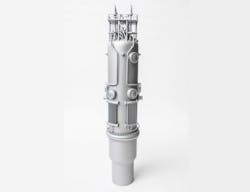NuScale Power planning Small Modular Reactor Nuclear project with Polish Industrial producer
The first global implementation of small modular nuclear reactors power for industry may happen in Poland.
U.S-based SMR designer NuScale Power has signed an agreement to initiate deployment of the company’s technology to Poland’s KGHM Polska Miedź S.A. (KGHM). KGHM is one of Poland’s key copper and silver producers and a large industrial power user.
If the NuScale VOYGR power plant is deployed as early as 2029, as planned, it could help Poland avoid up to 8 million tons of CO2 emissions per year, according to the release. SMR nuclear is carbon-free power generation, same as conventional reactor plants, but it operates on a much smaller land and environmental footprint.
“In the global race to rapidly decrease emissions worldwide, NuScale’s technology presents the perfect solution to reach this goal while simultaneously bringing economic prosperity to host countries,” said John Hopkins, NuScale Power President and Chief Executive Officer. “NuScale is proud to partner with KGHM, an experienced innovation leader, and we are excited to work together to bring forth the next era of advanced clean energy deployment and confront the climate crisis.”
NuScale and KGHM have been collaborating since September 2021. One of the first objectives following the agreement is to find a suitable project site for the SMR plant.
Poland’s power generation resource mix is dominated by coal and, in some cases, natural gas imported from Russia. The SMR nuclear plant solution will be analyzed as a possible option for replacing coal, which is the worst greenhouse gas polluter.
“KGHM is proud to lead the initiation of a 100% carbon free energy project, delivering on its commitment to lead efforts to decarbonize. The SMR technology will increase the company's cost efficiency and transform the Polish energy sector,” said Marcin Chludziński, President of the Management Board of KGHM Polska Miedź S.A.
The NuScale design has received some key approvals from the U.S. Nuclear Regulatory Commission and is being considered for several pilot projects in the nation. Conventional nuclear power plant construction projects are almost non-existent in the U.S. because of tremendous costs—such as the Vogtle expansion in Georgia, which is running up an estimated $29 billion tab because the units become operational this year and 2023.
The plants can vary from more than 300 MW to 900-plus MW depending on how many modules are contained.
About the Author
Rod Walton, EnergyTech Managing Editor
Managing Editor
For EnergyTech editorial inquiries, please contact Managing Editor Rod Walton at [email protected].
Rod Walton has spent 17 years covering the energy industry as a newspaper and trade journalist. He formerly was energy writer and business editor at the Tulsa World. Later, he spent six years covering the electricity power sector for Pennwell and Clarion Events. He joined Endeavor and EnergyTech in November 2021.
Walton earned his Bachelors degree in journalism from the University of Oklahoma. His career stops include the Moore American, Bartlesville Examiner-Enterprise, Wagoner Tribune and Tulsa World.
EnergyTech is focused on the mission critical and large-scale energy users and their sustainability and resiliency goals. These include the commercial and industrial sectors, as well as the military, universities, data centers and microgrids. The C&I sectors together account for close to 30 percent of greenhouse gas emissions in the U.S.
He was named Managing Editor for Microgrid Knowledge and EnergyTech starting July 1, 2023
Many large-scale energy users such as Fortune 500 companies, and mission-critical users such as military bases, universities, healthcare facilities, public safety and data centers, shifting their energy priorities to reach net-zero carbon goals within the coming decades. These include plans for renewable energy power purchase agreements, but also on-site resiliency projects such as microgrids, combined heat and power, rooftop solar, energy storage, digitalization and building efficiency upgrades.

